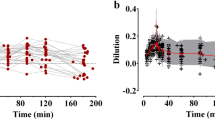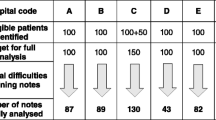Summary
Several multi-stage infusion regimens and a computer controlled exponentially decreasing infusion regimen were evaluated in twelve patients undergoing head and neck surgery or neurosurgery. Thiopentone dosage was based on the mean of pharmacokinetic parameter values from the literature and adjusted for each patient's lean body mass in order to rapidly achieve a predetermined plasma thiopentone concentration of 15 or 20 µg/ml in the period following the initial bolus dose to induce anaesthesia. Anaesthesia was satisfactory in all cases. Plasma thiopentone concentrations were maintained between 10–20 µg/ml during infusion in the five patients who received either a four or five stage infusion and in the six patients who received the exponential infusion, but not in the single patient who received a two-stage infusion. The mean recovery time was 111 min. The plasma concentrations of total and unbound thiopentone at awakening showed little intersubject variability, despite considerable differences in total dose and duration of infusion, suggesting the absence of acute tolerance to the drug. Plasma clearance of total thiopentone correlated strongly with calculated lean body mass and to a lesser extent with total body weight suggesting that lean body mass, in particular, should be an accurate predictor of thiopentone maintenance dose requirements. This study shows that it is feasible to use thiopentone as a primary anaesthetic agent during surgery by administering the drug either as an exponentially decreasing infusion or as an infusion comprising 4 or 5 stepwise decreasing rates.
Similar content being viewed by others
References
Becker KE (1978a) Plasma levels of thiopental necessary for anesthesia. Anesthesiology 49: 192–196
Becker KE (1978b) Cardiovascular effects of plasma levels of thiopentone necessary for anesthesia. Anesthesiology 49: 197–200
Benet LZ, Galeazzi RL (1979) Noncompartmental determination of the steady state volume of distribution. J Pharm Sci 68: 1071–1074
Breimer DD (1983) Interindividual variations in drug disposition, clinical implications and methods of investigation. Clin Pharmacokinet 8: 371–377
Brodie BB, Mark LC, Lief PA, Bernstein E, Papper EM (1951) Acute tolerance to thiopental. J Pharmacol Exp Ther 102: 215–218
Carlon GC, Kahn RC, Goldiner PL, Howland WS, Turnbull A (1978) Long term infusion of sodium thiopental: Hemodynamic and respiratory effects. Crit Care Med 6: 311–316
Chiou WL (1980) New calculation method of mean total body clearance of drugs and its application to dosage regimens. J Pharm Sci 69: 90–91
Christensen JH, Andreasen F, Jansen JA (1980) Pharmacokinetics of thiopentone in a group of young women and a group of young men. Br J Anaesth 52: 913–917
Christensen JH, Andreasen F, Jansen J (1983) Pharmacokinetics and pharmacodynamics of thiopental in patients undergoing renal transplantation. Acta Anesthesiol Scand 27: 513–518
Cloyd JC, Wright BD, Perrier D (1979) Pharmacokinetic properties of thiopentone in two patients treated for uncontrollable seizures. Epilepsia 20: 313–318
Crankshaw DP, Allt-Graham J (1978) ED50 values for thiopentone, methohexital, propanidid and alfathesin: A clinical experiment. Anaesth Intensive Care 6: 36–43
Dundee JW (1979) Intravenous anaesthetic agents. Edward Arnold, London, pp 146–155
Dundee JW, Price HL, Dripps RD (1956) Acute tolerance to thiopentone in man. Br J Anaesth 28: 344–352
Gibaldi M, Perrier D (1982) Pharmacokinetics. Marcel Dekker, New York
Greenblatt DJ, Bolognini V, Koch-Weser J, Harmatz JS (1976) Pharmacokinetic approach to the clinical use of lidocaine intravenously. J Am Med Assoc 236: 273–277
Hengstmann JH, Stoekel H, Schuttler J (1980) Infusion model for fentanyl based on pharmacokinetics analysis. Br J Anaesth 52: 1021–1025
Hudson RJ, Stanski DR, Saidman LJ, Meathe E (1983) A model for studying depth of anesthesia and acute tolerance to thiopental. Anesthesiology 59: 301–308
Jung D, Mayersohn M, Perrier D, Calkins J, Saunders R (1982) Thiopental disposition in lean and obese patients undergoing surgery. Anesthesiology 56: 269–274
Kruger-Thiemer E (1968) Continuous intravenous infusion and multicompartment accumulation. Eur J Pharmacol 4: 317–324
Mazze RI (1983) Inhalation Anaesthesiology. Clin Anaesthesiol 1: 431–519
Morgan DJ, Blackman GL, Paull JD, Wolf LJ (1981) Pharmacokinetics and plasma binding of thiopental. 1. Studies in surgical patients. Anesthesiology 54: 468–473
Pandele G, Chanx F, Salvadori C, Farinotti M, Duvaldestin P (1983) Thiopental pharmacokinetics in patients with cirrhosis. Anesthesiology 59: 123–126
Price HL (1960) A dynamic concept of the distribution of thiopental in the human body. Anesthesiology 21: 40–45
Schuttler J, Schwilden H, Stoekel H (1983) Pharmacokinetics as applied to total intravenous anaesthesia. Practical implication. Anaesthesia 38 Suppl: 53–56
Shand DG, Desjardins RE, Bjornsson TD, Hammill SC, Pritchell ELC (1981) The method of separate exponentials: A simple aid to devising intravenous drug loading regimens. Clin Pharmacol Ther 29: 542–547
Sokal RR, Rohlf FJ (1981) Biometry 2nd Ed. Freeman San Francisco
Stanski DR, Mihm FG, Rosenthal MH, Kalman SM (1980) Pharmacokinetics of high dose thiopental used in cerebral resuscitation. Anesthesiology 53: 169–171
Straughn AB (1982) Model-independent steady-state volume of distribution. J Pharm Sci 71: 597–598
Toner W, Howard PJ, McGowan WAW, Dundee JW (1980) Another look at acute tolerance to thiopentone. Br J Anaesth 52: 1005–1008
Tsuei SE, Nation RL, Thomas J (1980) Design of infusion regimens to achieve and maintain a predetermined plasma drug level range. Clin Pharmacol Ther 28: 289–292
Vaughan DP, Tucker GT (1975) General theory for rapidly establishing steady-state drug concentration using two consecutive constant rate infusions. Eur J Clin Pharmacol 9: 235–238
Vaughan DP, Tucker GT (1976) General derivation of the ideal intravenous drug input required to achieve and maintain a constant plasma drug concentration. Theoretical application to lignocaine therapy. Eur J Clin Pharmacol 10: 433–440
Wagner JG (1974) A safe method for rapidly achieving plasma concentration plateaus. Clin Pharmacol Ther 16: 691–700
Widmark EMP (1919) Studies in the concentrations of indifferent narcotics in blood and tissues. Acta Med Scand 52: 87–164
Wulfsohn NL, Joshi CW (1969) Thiopentone dosage based on lean body mass. Br J Anaesth 41: 516–521
Author information
Authors and Affiliations
Rights and permissions
About this article
Cite this article
Crankshaw, D.P., Edwards, N.E., Blackman, G.L. et al. Evaluation of infusion regimens for thiopentone as a primary anaesthetic agent. Eur J Clin Pharmacol 28, 543–552 (1985). https://doi.org/10.1007/BF00544065
Received:
Revised:
Accepted:
Issue Date:
DOI: https://doi.org/10.1007/BF00544065




